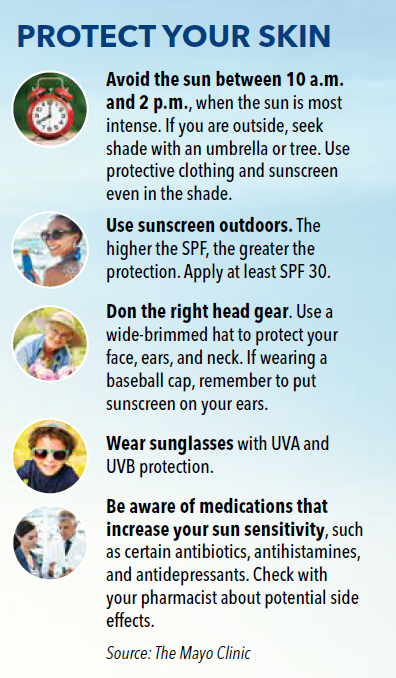More Than Skin Deep: Frequent Checks Important for Early Cancer Detection
Skin cancer doesn’t always look like trouble.

Though most of us would know to seek a medical opinion over a suspicious mole, other patches may not seem questionable at all. That’s why regular skin checks — through self-exams, as well as appointments with your family physician or dermatologist — are important. Basal cell carcinoma, the most common type of skin cancer, frequently looks like a flesh-colored, pearl-like bump, or raised reddish patch that might be itchy. They can also appear to be flat, firm, pale, or yellow areas, similar to a scar, or pink growths with raised edges. These can develop anywhere on the body after years of frequent sun exposure or indoor tanning.
Suspicious areas can also look like dry, rough, scaly patches or spots that may be flesh-colored or pink-red. Known as actinic keratoses, these spots usually appear on areas prone to frequent sun exposure: the neck, head, hands, and forearms, according to the American Cancer Society. People with one actinic keratosis often develop many more. These spots could stay the same, clear up on their own, or develop into squamous cell carcinoma, so seeking a professional opinion is key.
Red firm bumps, scaly patches, wart-like growths, sores that heal but then come back — these could be indicative of squamous cell carcinoma. The rims of the ears, neck, back, face, arms, and chest are frequently affected by these growths, which can develop deep in the skin and spread to other areas of the body.
Melanoma, the deadliest form of skin cancer, usually develops in a mole or suddenly appears as a new dark spot on the skin. “Most people have moles, and almost all moles are harmless,” states the American Cancer Society. “But it’s important to notice changes in a mole — such as its size, shape, or color — because that may be a sign that melanoma is developing.”
“Regardless of your skin suspicions, catching them early is very important,” said Temeria Wilcox, CRNP, a board-certified family nurse practitioner at MedStar Health Primary Care at East Run Center in Lexington Park. “Because basal cell carcinoma, in particular, can invade the surrounding tissue and grow into the nerves and bones, preventing permanent damage starts with doing regular skin checks, keeping appointments for routine physicals, and seeing a doctor right away with any skin concerns.”
When doing a self-exam, note your standard birthmarks, moles, and other blemishes, and have a partner help inspect hard-to-reach areas like your back and neck. Regular exams are especially important for those at a higher risk of skin cancer: people with reduced immunity; those who have had skin cancer before; and people with a strong family history of the disease.
“Be aware of your normal pattern of moles, freckles, and blemishes,” Temeria advised. “Checking your own skin frequently can help find many skin cancers early, when they are easier to treat. Your doctor can work with you as a part of your routine physical and overall wellness.”
Visit MedStarStMarys.org/SkinCheck to learn more about skin health.
What to Look For:
The A, B, C, D, Es of Melanoma
___________________________
A- ASYMMETRY
One half is unlike the other half.
B - BORDER
An irregular, scalloped, or poorly defined border.
C - COLOR
Varied from one area to another; has shades of tan, brown or black, or is sometimes white, red, or blue.
D - DIAMETER
Melanomas are usually greater than 6mm (the size of a pencil eraser) when diagnosed, but they can be smaller.
E - EVOLVING
A mole or skin lesion that looks different from the rest or is changing in the size, shape, or color. If a spot changes, itches, bleeds, or is different from others, see your doctor or dermatologist.
Source: American Academy of Dermatology









